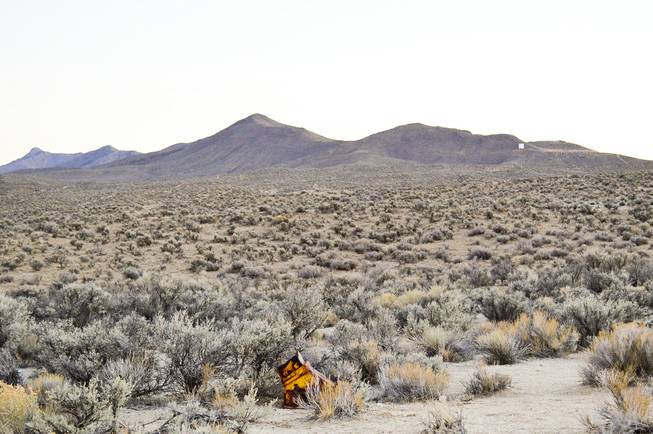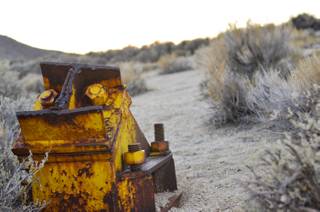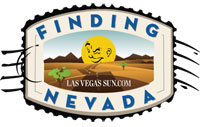
At the Project Shoal site, where a nuclear weapon was detonated on Oct. 26, 1963, about 1,200 feet underground, there’s little evidence of the blast. This piece of aged metal provides some of the only color on the site in Churchill County, Thursday, Oct. 24, 2013.
Tuesday, Oct. 29, 2013 | 2 a.m.
Along Highway 50 east of Fallon, at the former Old Middlegate Station overland stage and Pony Express stop that now passes as a dark bar and grill, travelers and desert rats sit beneath dingy dollar bills pinned to the ceiling and swap stories. The later the evening goes, the more answers they have.
Except the one about the nuclear bomb that was detonated, nearby, 50 years ago almost to the day.
The bartender leans forward, with a quizzical look on her face.
“What?” she asks. “Where?”
Down the well-worn bar, a man drinking a Diet Coke looks confused. You mean by Beatty, he says, near the Nevada Test Site.
No, not really, he’s told.
This explosion occurred between Fallon and Middlegate in a lifeless-looking place called GZ Canyon. There are a few man-made structures that show the continued presence of the Navy, which has bombing ranges nearby. But other than a stray four-wheeler crawling up the dirt roads or a military jet screaming overhead from Fallon Naval Air Station, there’s not much else but gray scrub brush and quiet.
Look hard enough, though, and you’ll notice a concrete pad, badly cracked. And some short pieces of rebar bent like a candy cane. And twisted hunks of rusted metal, and thick electrical cables snaking their way up from under the ground.
These are the detritus of a nuclear blast, 1,200 feet below in the granite hillside, set off Oct. 26, 1963. This was the government’s Project Shoal, a 12.5-kiloton blast (equivalent to 12,500 tons of TNT) to study how to detect deep underground nuclear testing in other countries.
The Shoal site is one of two places in the state outside of the Nevada Test Site where the government exploded nuclear weapons. Unlike the test site, where there were more than 900 “shots,” both of these sites are accessible to the public via dirt roads, though they’re not easy to get to or find. They are the less-famous reminders of Nevada’s nuclear past.
The other site, Project Faultless in Nye County, northeast of Warm Springs, has an 8-foot-high drill casing with a small plaque describing the test.
A sign on the Shoal site was destroyed in the 1980s during some sort of explosion, according to the Nevada Division of Environmental Protection. There’s now a tombstone-like marker that’s hard to find in the knee-high scrub.
The remoteness of the area, roughly 50 miles from Fallon in the Sand Springs Mountains, is a key reason why this place was chosen. A person has to make an effort to get this far off road.
People do come here to go four-wheeling or get away. A firepit shows recent activity. But mostly there is little to mar the serene, if simple, beauty of the spot.
Both the state and federal government say there’s no immediate concern about radiation here. There was some contamination, caused by test drilling after the blast, but that was buried in the late 1990s. There is significant damage and radiation down several hundred feet, and that will remain for tens of thousands of years. But on the surface, the general advice is that you’ll be fine as long as you don’t dig deep or eat the dirt.
The 50th anniversary of the blast passed as the others have, with few people noticing. The significance is largely lost, the activity that once was here is long forgotten.
The only real reminder of the test is the name: The initials in GZ Canyon stand for ground zero. Not that you’d ever find it.
So now the folks at the Old Middlegate Station have one more answer.

 Follow along as the Sun explores and defines Nevada
Follow along as the Sun explores and defines Nevada
Join the Discussion:
Check this out for a full explanation of our conversion to the LiveFyre commenting system and instructions on how to sign up for an account.
Full comments policy